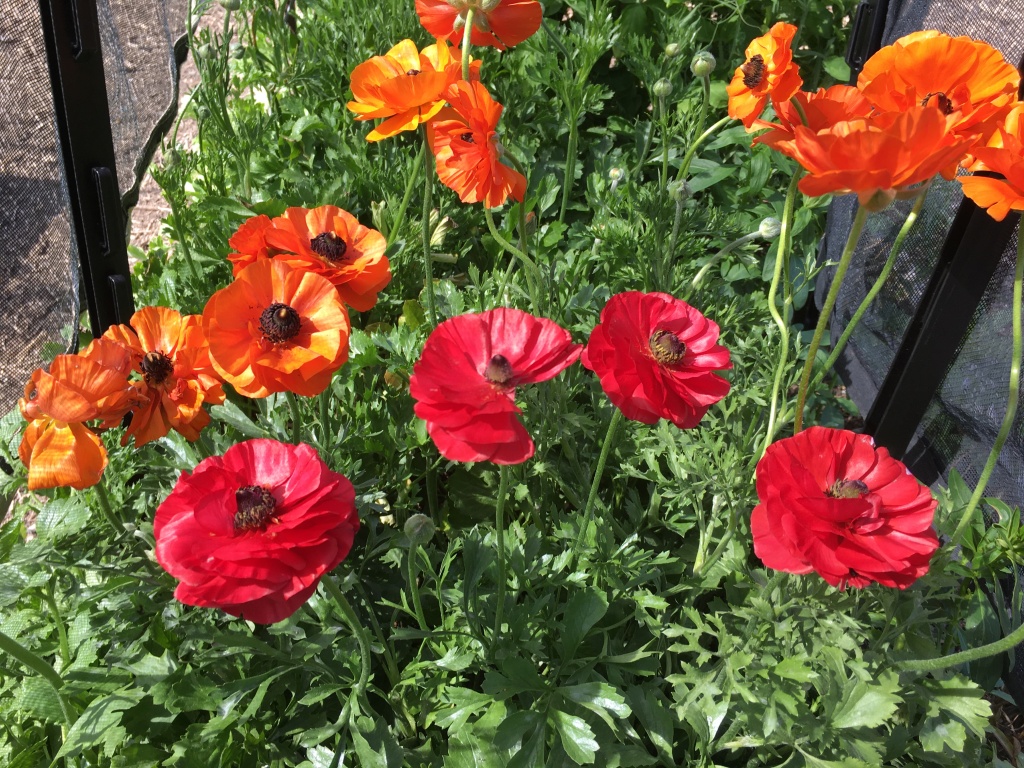
It’s time to start the ranunculus here in Zone 5b/6a. This will be my third year growing these flowers, and I can say it has been a learning curve. First of all, those of you who follow a lot of Instagram, YouTube, etc. will notice that these blooms are not the huge, million-petaled flowers that others show off. I love ranunculus because it is one of the essential “May Gap” fillers here in central Indiana, especially if one doesn’t have peonies (and I don’t.) Keep in mind that I grow flowers to give away. I’m not growing for profit anymore. Those showy, usually Italian or cloned varieties are many dollars per corm (like 3 for $24!) so I can’t afford to put several in one bouquet. That’s just not in my budget since I need lots, so I grow the less expensive, but still pretty varieties. Secondly, please note if I were picking ranunculus for bouquets, they should have been picked much sooner than those in the photograph, which are fully opened with the dark center already fully exposed. That’s too late for long vase life.

Ranunculus can be grown from seed, but they are normally grown from corms. For a comparison of some of the most common sources that I’ve used, you may want to read last year’s post “Corm Comparison.” Different growing zones can use differing methods. Those living in warmer zones can leave the corms in the ground overwinter from year to year, some areas can plant safely in the autumn to harvest in very early spring. I accidentally left a corm in the ground, and it grew up again in the coolness of autumn so I’m leaving it to see if by chance it survives and blooms again, or if it disappears. However, it is recommended for our zone to plant early in the spring, partly because we usually have frozen soil for months and partly because our soil tends to be heavy clay that holds moisture too long causing corms to rot. Another problem is that our spring is often short, and quickly turns into summer. Ranunculus hates temperatures over 78 degrees F, and will shut-down, draw all the nutrients from the leaves into the corm for storage and go into hibernation mode. Last year we hit 90 degrees the second week of May! Ugh! The ranunculus didn’t have much time to draw in those nutrients, and I noticed when dug the corms had not gained much size at all. I’m not sure how well my saved corms will do, so I ordered several more as insurance. (Plus I can never have too many flowers!)
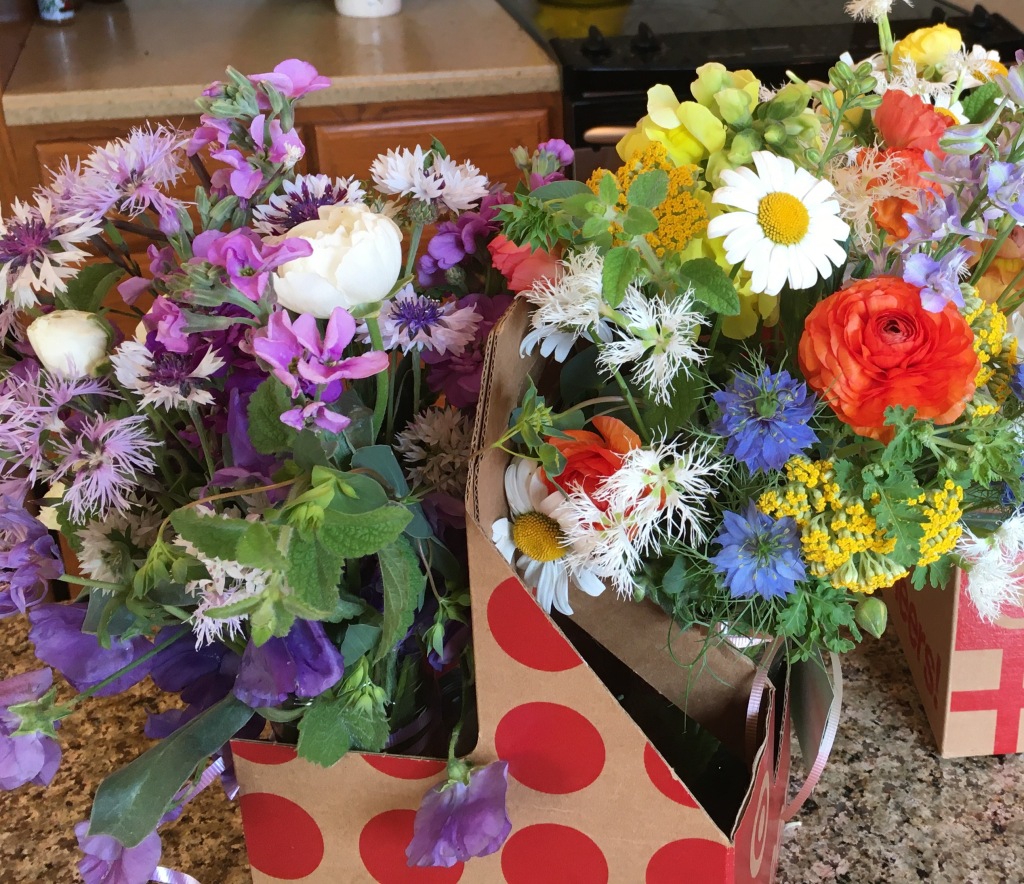
To get a long enough growing season, I pre-sprout the corms. The first step is to soak the corms in water for about 3 hours. I change the water each hour to help keep oxygen levels up. Some people use a bubbler, but I haven’t had any problems without one.
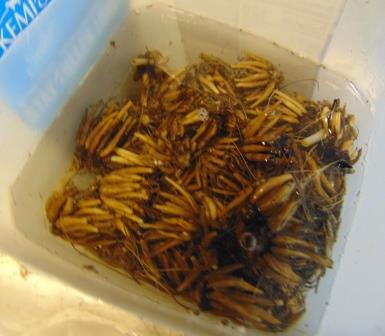
While the corms are soaking, I put two inches of moistened potting soil into trays with drainage holes and make variety labels. I also usually have to clear a space on the shelves in the cool, dark room where my dahlia tubers are also being stored. When the soaking time is up, I place each corm, which looks like an octopus, tentacles pointed down in the tray leaving about half an inch between corms all around. Once the tray is filled and the label is added, it goes onto the shelves in the dark room. They don’t need light at this stage. I do check them every few days to ensure that the soil remains moist (but NOT WET!) I’ve also learned to keep a mouse trap or two set because they love to dig the corms out willy-nilly, and may nibble on them as well. We don’t normally have mice in our basement, but once in a while they find a way in so prevention is wise.

In a week but usually two, depending upon temperature and the strength of the corms, white pointed tips poke through the soil that becomes green growth, and at that point the trays need to go under lights. I have two rooms in the basement for growing, one warm and one cool and the ranunculus goes into the cooler room where the top grows slowly but the roots grow chunky.
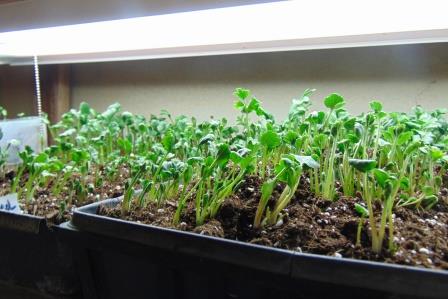
What happens next depends upon the weather. The tender plants need to be gradually exposed to real sunlight and wind, which is called “hardening off.” The first year the trays were moved outdoors on mild, cloudy days and back in if temperatures dropped. That’s a lot of hassle, even if there are only two or three trays. I also learned the hard way that the rabbits will hop up on a 3′ tall table to eat anything green after a long winter. The second year there were several more flats to lug in and out so I needed a new plan. Simply opening the greenhouse door and turning on the fan to simulate wind is a lot easier than moving the trays in and out, and there’s no danger of rabbit raids, and as I get older I am more tempted to use the greenhouse. However, my very inefficient greenhouse is really not capable of keeping plants very warm if temperatures get in the teens even with the heater on, and I hate to have to plug in the heater so early in the year. So last year, I skipped that hardening off period and just planted directly into the raised beds under low tunnels of heavy frost covering. If the long-term forecast is decent (not extended periods of below 28 degrees) that’s the preferred plan. If the weather doesn’t cooperate I leave them in the flat, but the longer they are there the more the roots intertwine and get crowded. Also remember that we have a narrow window of cool spring and the set-back plants get from roots being torn and broken is sometimes just too much, as I found out in year one. Last year I did a mixture of both direct from flat planting, and up-potting. The first batch went directly into the beds March 3rd. But then winter returned with a vengeance. We had a very late, cold, wet spring and many of the plants already in the beds rotted. The ones in 4” pots in the greenhouse that were set into beds a few weeks later actually fared much better, so I’ll probably do some of both this year to hedge my bets.
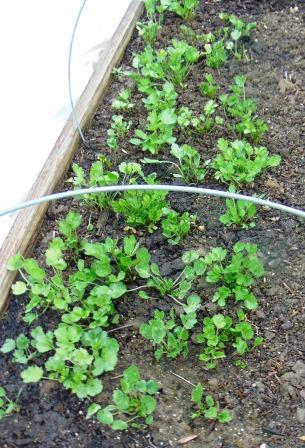
When set into the beds, already enriched with compost, the plants are spaced 6″ apart and the corms about 3″ deep even if that covers up some leaves. Planting deep helps keep the roots cooler. Once in the ground, mulching well will also help keep roots cool. I didn’t do that the first year, but I do it now. I use a low tunnel with a double layer of Agribon Plus, open whenever possible, closed if temps drop below 30. If an extended period of rain is forecast, this year I’ll put a layer of plastic over the hoops as well in an attempt to keep the soil a bit drier to avoid rot. I expect/hope to harvest the second week of May or maybe a week earlier, if Mother Nature co-operates.
In addition to the 125 “saved” corms (Telecote Salmon, Telecote Orange & Red Shades, French Peony Mix, Telecote Pastel Mix) from years past, here are the new additions:

Several of the corms were purchased from Longfield Gardens, like the purple ones above. The Tomer series has more petals than the Telecote, if judged by the photos. 100 of these, and since many of my bouquet recipients love purple, I think these will be a hit. In addition, there will be 100 of the Tomer Pink & White Mix.
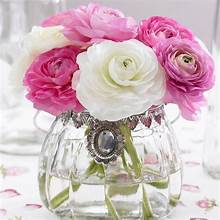
And, to round out the Tomer group, there’s 125 of the Tomer Mix.

I decided to give the Aviv Series a try, but since they are more expensive only 25 of these Aviv Picotee were ordered. We’ll see if they are worth the extra cost.
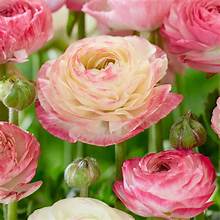
I’ve always been happy with the corms from Van Engelen, so there 100 of their Giant Mix just now poking through the soil after their pre-soak.

And just because I’m crossing my fingers (and toes) that there will be ranunculus for Mother’s Day, I’ve added another 60 Pastel Peony Mix from Holland Bulb Farms. This is probably wishful thinking, because Mother’s Day is early this year…
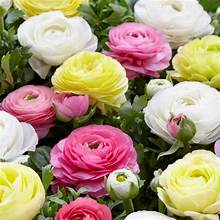
Can you tell that I’m excited about this year’s ranunculus? Wouldn’t it be lovely if the 80-90 degree temps held off until the last of May? We’ll just have to wait and see what happens. The life of a gardener/farmer is always a gamble, isn’t it?

You are so generous with your advice Carolee! I don’t grow ranunculus bit if I did I would be saving this post as a guide.
LikeLike
I think most gardeners like to share their experience, and save others from the mistakes and hassle of a slow learning curve….
LikeLiked by 1 person
Well I appreciate learning from you.
LikeLike
I have never grown any and it helps to know what you are doing. I didn’t last season when Growing Kindness sent a few in their box. They never did any thing …My fault I’m sure. But goodness…what a pretty flower. Thank you for the very detailed information.
LikeLike
interesting…Growing Kindness has never sent me a box!!!
LikeLiked by 1 person
Well it was part of Ambassador . LOL…I probably even paid for it.,but it was kind of a disappointment.
LikeLike
First year growing these. I soaked the corms for 6 hours and planted 3 to a pot in sharp/gritty soil. They are now in the greenhouse but wondering if I should bring them in the house for a bit more warmth?
LikeLike
depends on temps in your greenhouse…too cold (below 40) and they may rot before they root…above 78 and they won’t flower, or won’t flower nicely (few and short before they quit entirely)
LikeLiked by 1 person
Thanks for that 0c forecast for the weekend so I’ve reserved a app for them on the kitchen windowsill 😊
LikeLike
That deep purple is amazing.
LikeLike
Yes, it is! I only had one in a mix last year and knew I needed more!
LikeLike